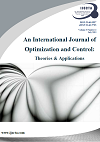Minimization over randomly selected lines
DOI:
https://doi.org/10.11121/ijocta.01.2013.00167Keywords:
Random Lines, nonlinear optimization, evolutionary optimization, population-based optimization, quadratic interpolation, crossover operator, mutation operator, stopping criterion, Differential Evolution, Particle SwarmAbstract
This paper presents a population-based evolutionary optimization method for minimizing a given cost function. The mutation operator of this method selects randomly oriented lines in the cost function domain, constructs quadratic functions interpolating the cost function at three different points over each line, and uses extrema of the quadratics as mutated points. The crossover operator modifies each mutated point based on components of two points in population, instead of one point as is usually performed in other evolutionary algorithms. The stopping criterion of this method depends on the number of almost degenerate quadratics. We demonstrate that the proposed method with these mutation and crossover operations achieves faster and more robust convergence than the well-known Differential Evolution and Particle Swarm algorithms.Downloads
References
Torn, A., Global optimization. Springer-Verlag (1989). Crossref
Price, K., Storn, R.M., Lampinen, J.A., Differential evolution: a practical approach to global optimization. Springer-Verlag, Berlin (2005).
Tu, T.V., Sano, K., Genetic algorithm for optimization in adaptive bus signal priority control. An International Journal of Optimization and Control: Theories and Applications (IJOCTA), 3(1), 35–43 (2012). Crossref
Luenberger, D.G., Ye, Y., Linear and nonlinear programming. Springer, New York (2008).
Dennis, J.E., Schnabel, R.B., Numerical methods for unconstrained optimization and nonlinear equations. SIAM (1987).
More, J.J., Thuente, D.J., Line search algorithms with guaranteed sufficient decrease. ACM Transactions on Mathematical Software, 20(3), 286–307 (1994). Crossref
Mohan, C., Shanker, K., A controlled random search technique for global optimization using quadratic approximation. Asia-Pacic Journal of Operational Research, 11(1), 93–101 (1994).
Pant, M., Thangaraj, R., Singh, V.P., A new differential evolution algorithm for solving global optimization problems. International Conference on Advanced Computer Control (ICACC’09), 388-392 (2009)
Storn, R., Price, K., Differential evolution a simple and efficient heuristic for global optimization over continuous spaces. Journal of Global Optimization, 11(4), 341-359 (1997). Crossref
Montgomery, J., Chen, S., An analysis of the operation of differential evolution at high and low crossover rates. IEEE Congress on Evolutionary Computation (CEC’2010), 1-8 (2010). Crossref
Onwubolu, G., Davendra, D., Scheduling flow shops using differential evolution algorithm. European Journal of Operational Research, 171(2), 674–692 (2006). Crossref
Sahin, I., Random Lines: a novel population set-based evolutionary global optimization algorithm. Genetic Programming vol. 6621, 97-107, Springer-Verlag, Berlin (2011).
Zielinski, K., Weitkemper, P., Laur, R., Kammeyer, K.-D., Examination of stopping criteria for differential evolution based on a power allocation problem. 10th International Conference on Optimization of Electrical and Electronic Equipment, Brasov, Romania (2006).
Rahnamayan, S., Tizhoosh, H.R., Salama, M.M.A., Opposition-based Differential Evolution. IEEE Transactions on Evolutionary Computation, 12(1), 64-79 (2008). Crossref
More, J.J., Garbow, B.S., Hillstrom, K.E., Testing unconstrained optimization software. Acm Transactions on Mathematical Software, 7(1), 17-41 (1981). Crossref
Aluffipentini, F., Parisi, V., Zirilli, F., Global optimization and stochastic differential-equations. Journal of Optimization Theory and Applications, 47(1), 1-16 (1985). Crossref
Ali, M.M., Khompatraporn, C., Zabinsky, Z.B., A numerical evaluation of several stochastic algorithms on selected continuous global optimization test problems. Journal of Global Optimization, 31(4), 635-672 (2005). Crossref
budidaya tani. (2015). Retrieved 21 May 2015, from https://www.budidayatani.com
Clerc, M., Kennedy, J., The particle swarm - explosion, stability, and convergence in a multidimensional complex space. IEEE Transactions on Evolutionary Computation, 6(1), 58-73 (2002). Crossref
Ali, M.M., Kaelo, P., Improved particle swarm algorithms for global optimization. Applied Mathematics and Computation, 196(2), 578-593 (2008). Crossref
Ali, M.M., T¨orn, A., Population set-based global optimization algorithms: some modiï¬cations and numerical studies. Computers and Operations Research, 31(10), 1703-1725 (2004). Crossref
Yao, X., Liu, Y., Lin, G., Evolutionary programming made faster. IEEE Transactions on Evolutionary Computation, 3(2), 82 -102 (1999). Crossref
Downloads
Published
How to Cite
Issue
Section
License
Articles published in IJOCTA are made freely available online immediately upon publication, without subscription barriers to access. All articles published in this journal are licensed under the Creative Commons Attribution 4.0 International License (click here to read the full-text legal code). This broad license was developed to facilitate open access to, and free use of, original works of all types. Applying this standard license to your work will ensure your right to make your work freely and openly available.
Under the Creative Commons Attribution 4.0 International License, authors retain ownership of the copyright for their article, but authors allow anyone to download, reuse, reprint, modify, distribute, and/or copy articles in IJOCTA, so long as the original authors and source are credited.
The readers are free to:
- Share — copy and redistribute the material in any medium or format
- Adapt — remix, transform, and build upon the material
- for any purpose, even commercially.
- The licensor cannot revoke these freedoms as long as you follow the license terms.
under the following terms:
- Attribution — You must give appropriate credit, provide a link to the license, and indicate if changes were made. You may do so in any reasonable manner, but not in any way that suggests the licensor endorses you or your use.
- No additional restrictions — You may not apply legal terms or technological measures that legally restrict others from doing anything the license permits.
 This work is licensed under a Creative Commons Attribution 4.0 International License.
This work is licensed under a Creative Commons Attribution 4.0 International License.












